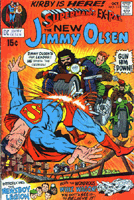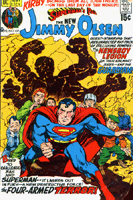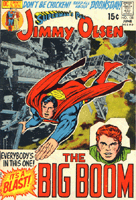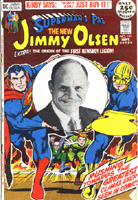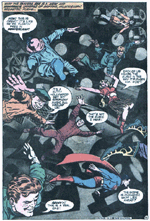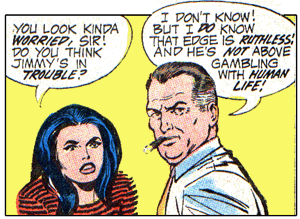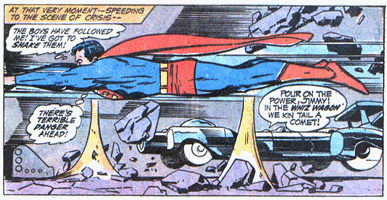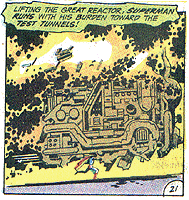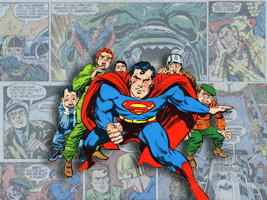Jimmy Olsen became
the unofficial fourth corner of the Fourth World, as Kirby
transformed the dull-witted cub reporter into a rough-and-ready
adventurer in the mold of the Challengers of the Unknown.
Under Kirby's guidance, Jimmy became a leader of men,
a bold hero in his own right and -- by virtue of his age
-- our liaison to an incredible secret world of super-hippies
with the wardrobes of beatniks and a technology to rival
Krypton's own. One can only imagine the amazement of readers
who picked up issue 133 expecting more of the same "how
do I impress Lucy Lane...oops I've turned into a giant
turtle" goofiness, and finding instead an outlaw
biker gang, the space-age "Whiz Wagon" and a
Jimmy Olsen ready to tune in, turn on and drop out! It
was almost as unimaginable as Archie Andrews quitting
Riverdale High to follow the Grateful Dead.
|
|
| Click
for a better view of this groovy trip, man! |
Kirby showed his fascination with America's "youth
culture" (or maybe just his eagerness to earn their
business) by introducing bizarre hippie-like slang, mod
fashions and dreamy psychadelic imagery. In issue 137,
a gadget called the "Solar Phone" enabled Superman,
Jimmy and a room full of young people to take a group
"mind trip" through a realm of groovy images
and (we're told) sounds and sensations. It's a perfect
Kirby "cheat": Superman would never take drugs,
but he does "do" science, and the Solar-Phone
is the electronic equivalent of an acid tab (It's also
a good chance for Kirby to show off his new mastery of
the photo montage). Although some of the young people
(Outsiders, Forever People and "Hairies") think
Superman's pretty cool (and hunky!), he's really only
welcome because he's "Jimmy Olsen's Pal" (a
neat twist) because, after all, you can't really trust
anyone over 30, even if he does wear the big red "S."
Nonetheless, when it comes time to feature
a real-life celebrity in the book, Kirby opts not for Janis
Joplin, Jim Morrison, Timothy Leary or another icon of the
counter-culture, but instead for the (then) middle-aged
Vegas comedian Don Rickles (!) who appears not only as his
vitriolic, mean-spirited self but also as an insufferably
nicey-nice doppleganger named "Goody Rickles."
Hmm...maybe Kirby left that Solar Phone on a bit too long!
Just to keep the kookiness rolling along, the cover blurbs
featured such unconventional (or just nutty?) exclamations
as "Don't Be Chicken, Read All About DOOMSDAY!"
and "Kirby Says: 'Don't Ask, Just Buy It!'"
 |
|
Above: The Four-Armed
Terror, Stuff of Nightmares
|
| Below: Superman "family
member" Perry White gets a Murphy Anderson
head; Kirby creation Terry Dean doesn't. |
|
|
Of course this was all over my head
at the tender age of 6. All I knew was that the "Four-Armed
Terror" in Issue 137 was just about the scariest
thing I had ever seen (I still get goosebumps!), and
that Kirby's Superman seemed fit to burst with power,
compared to the laid back, reserved Curt
Swan model. Even as a first-grader I knew this version
of Superman was wildly different from the rest.
In fact it was so different
that DC worried readers might be scared off. In a still-controversial
move, they had the heads of all Superman "family"
characters re-drawn (or at least inked over) by established
Superman artists Al Plastino and Murphy Anderson. Many
Kirby fans have been outraged over this on his behalf,
but the artist himself seems not have minded much.
Personally, even when I got
old enough to know the difference, I wasn't about to complain.
Whereas I loved Kirby's machines and vehicles, and his
phenomenal fight scenes, I never much cared for his faces,
which often seemed hard and glowering, with their heavy
brows, broken noses and those weird squiggly lines that
made it look like everyone's epidermis was sheathed with
a thin layer of lucite. With Kirby handling designs, layouts
and poses, and the DC "bullpen" adding handsome
faces, I had the best of both worlds. Anyway, it beat
having Superman inked by the dreaded Vince Colletta, whose
inks elsewhere in the book (and on other Kirby works)
could most charitably be described as "merely adequate."
Kirby's contributions to
the Superman mythos came as much through his writing as
his artwork. Plots centered around "The Project,"
a secret underground complex with nebulous governmental
connections and dedicated to cracking the human genetic
code. Results of these almost heretical experiments included
the resurrection of Kirby's Golden Age hero The Guardian
(actually a clone of the original), the introduction of
Kirby's "DNAliens" and many disturbing mutations
of humanity in miniature, gigantic, superhuman and monstrous
forms. Pretty amazing stuff for 30 years ago, and more
timely than ever given today's headlines. Kirby dealt
with the possibilities -- both good and bad -- offered
by man's mastery of genetics, and raised serious ethical
questions in the process. As with much of Kirby's work,
the Jimmy Olsen run showed science as both our
salvation and our potential ruin.
|
|
|
|
Hallmarks of
Kirby's Superman: Speed (left) and strength (right).
|
Ultimately, Kirby's run was
fairly brief, but it left a lasting mark on the mythos
and on the next generation of creators. Elements from
the series have cropped up in the post-Crisis Superman
books (notably Project Cadmus, DNAliens, Dubbilex and
The Guardian) and on the recent Warner Brothers animated
series, to wonderful effect.
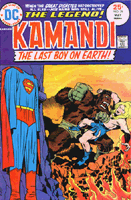 A
few years after Olsen, in his comic Kamandi,
Kirby dealt with the legacy of Superman, as "the
Last Boy On Earth" encounters a race of intelligent
apes who worship Superman's costume and await the day
he will return to claim it and save the Earth from post-Apocalyptic
chaos. Interesting here is the fact that Kamandi comes
to revere the outfit himself, and believes Superman will
indeed fulfill the prophecy. It's the sort of "superhero
as modern-day god" story that Kirby did so well.
A
few years after Olsen, in his comic Kamandi,
Kirby dealt with the legacy of Superman, as "the
Last Boy On Earth" encounters a race of intelligent
apes who worship Superman's costume and await the day
he will return to claim it and save the Earth from post-Apocalyptic
chaos. Interesting here is the fact that Kamandi comes
to revere the outfit himself, and believes Superman will
indeed fulfill the prophecy. It's the sort of "superhero
as modern-day god" story that Kirby did so well.
By the mid-70's, Kirby was
back at Marvel for a new take on Captain America and experimental
concepts like Machine Man and Devil Dinosaur.
Later still, he would be an early player in the emerging
independent comics market with several new creations.
His work on Superman was limited to the mid-80's "Super-Powers"
miniseries (where he was allowed to draw Superman's head
at last!) and the occasional "pin-up" for special
anniversary issues like Superman no. 400.
But in most minds, Jack's
best Superman work remains those issues of Jimmy Olsen.
In fact, while most of the artists on my "favorites"
list are here because of their pencilling or inking styles,
Kirby is more an "artist" in the classical sense:
he's a creator with a remarkable sense of vision. Like
other great "artists," be they writer, sculptor
or performer, his "art" is uniquely personal
and instantly recognizable, with a message that resonates
with audiences of many generations. Those of us who were
around see Kirby take the confident, easy-going, and --
yes -- even dull Superman of 1970 and throw him
headlong into a Marvel-like realm of action, terror and
cosmic adventure can only daydream about what might have
been, had he taken on Superman and Action Comics.
But now, of course, we'll
never know, as "King Kirby's" no longer with
us, except through the many wonderful stories he's left
behind. Long live the King!

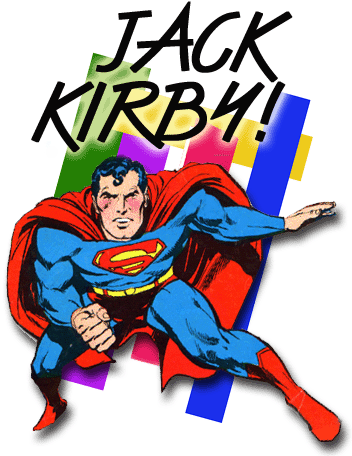 "Wild
Area! Zoomway! Habitat! Outsiders! Strange names in a
strange world which was evolved in a great natural cavern
beneath modern America! This is the world of the "Project"
-- where the Secret of the Century has been kept! The Harnessing
of the DNA Molecule!!!! The Breaking of the Genetic
Code!! MAN EXPERIMENTING WITH LIFE!!"
"Wild
Area! Zoomway! Habitat! Outsiders! Strange names in a
strange world which was evolved in a great natural cavern
beneath modern America! This is the world of the "Project"
-- where the Secret of the Century has been kept! The Harnessing
of the DNA Molecule!!!! The Breaking of the Genetic
Code!! MAN EXPERIMENTING WITH LIFE!!"